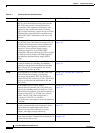
2-8
Cisco ONS 15454 Reference Manual, R7.0
78-17191-01
Chapter 2 Common Control Cards
2.2 2.2.2 TCC2 Card-Level Indicators
The TCC2 card also originates and terminates a cell bus carried over the module. The cell bus supports
links between any two cards in the node, which is essential for peer-to-peer communication. Peer-to-peer
communication accelerates protection switching for redundant cards.
The node database, IP address, and system software are stored in TCC2 card nonvolatile memory, which
allows quick recovery in the event of a power or card failure.
The TCC2 card performs all system-timing functions for each ONS 15454. The TCC2 monitors the
recovered clocks from each traffic card and two BITS ports (DS1, 1.544 MHz) for frequency accuracy.
The TCC2 selects a recovered clock, a BITS, or an internal Stratum 3 reference as the system-timing
reference. You can provision any of the clock inputs as primary or secondary timing sources. A
slow-reference tracking loop allows the TCC2 to synchronize with the recovered clock, which provides
holdover if the reference is lost.
The TCC2 monitors both supply voltage inputs on the shelf. An alarm is generated if one of the supply
voltage inputs has a voltage out of the specified range.
Install TCC2 cards in Slots 7 and 11 for redundancy. If the active TCC2 fails, traffic switches to the
protect TCC2. All TCC2 protection switches conform to protection switching standards when the bit
error rate (BER) counts are not in excess of 1 * 10 exp – 3 and completion time is less than 50 ms.
The TCC2 card has two built-in interface ports for accessing the system: an RJ-45 10BaseT LAN
interface and an EIA/TIA-232 ASCII interface for local craft access. It also has a 10BaseT LAN port for
user interfaces over the backplane.
Note When using the LAN RJ-45 craft interface or back panel wirewrap LAN connection, the connection must
be 10BASE T, half duplex. Full duplex and autonegotiate settings should not be used because they might
result in a loss of visibility to the node.
Note Cisco does not support operation of the ONS 15454 with only one TCC2 card. For full functionality and
to safeguard your system, always operate with two TCC2 cards.
Note When a second TCC2 card is inserted into a node, it synchronizes its software, its backup software, and
its database with the active TCC2. If the software version of the new TCC2 does not match the version
on the active TCC2, the newly inserted TCC2 copies from the active TCC2, taking about
15 to 20 minutes to complete. If the backup software version on the new TCC2 does not match the
version on the active TCC2, the newly inserted TCC2 copies the backup software from the active TCC2
again, taking about 15 to 20 minutes. Copying the database from the active TCC2 takes about 3 minutes.
Depending on the software version and backup version the new TCC2 started with, the entire process
can take between 3 and 40 minutes.
2.2.2 TCC2 Card-Level Indicators
The TCC2 faceplate has ten LEDs. Table 2-8 describes the two card-level LEDs on the TCC2 card
faceplate.


















